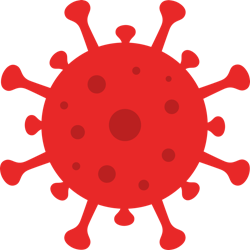Blocking immune system pathway may stop COVID-19 infection, study says
Researchers at Johns Hopkins Medicine have identified a means of stopping the severe impact of a COVID-19 infection. The key is blocking a protein that enables the virus to turn the immune system against healthy cells, according to a press release from the university. Based on their findings, the researchers believe that inhibiting the protein, known as factor D, also will curtail the potentially deadly inflammatory reactions that many patients have to the virus. The study is published in the September 2, 2020, issue of the journal Blood.
Scientists already know that spike proteins on the surface of the SARS-CoV-2 virus — making the pathogen look like the spiny ball from a medieval mace — are the means by which it attaches to cells targeted for infection. To do this, the spikes first grab hold of heparan sulfate, a large, complex sugar molecule found on the surface of cells in the lungs, blood vessels and smooth muscle making up most organs. Facilitated by its initial binding with heparan sulfate, SARS-CoV-2 then uses another cell-surface component, the protein known as angiotensin-converting enzyme 2 (ACE2), as its doorway into the attacked cell.
The Johns Hopkins Medicine team discovered that when SARS-CoV-2 ties up heparan sulfate, it prevents factor H from using the sugar molecule to bind with cells. Factor H’s normal function is to regulate the chemical signals that trigger inflammation and keep the immune system from harming healthy cells. Without this protection, cells in the lungs, heart, kidneys and other organs can be destroyed by the defense mechanism nature intended to safeguard them.
The APC is one of three chain reaction processes involving the splitting and combining of more than 20 different proteins — known as complement proteins — that usually gets activated when bacteria or viruses invade the body. The end product of this complement cascade, a structure called membrane attack complex (MAC), forms on the surface of the invader and causes its destruction, either by creating holes in bacterial membranes or disrupting a virus’ outer envelope. However, MACs also can arise on the membranes of healthy cells. Fortunately, humans have a number of complement proteins, including factor H, that regulate the APC, keep it in check and therefore, protect normal cells from damage by MACs.
In a series of experiments, the researchers used normal human blood serum and three subunits of the SARS-CoV-2 spike protein to discover exactly how the virus activates the APC, hijacks the immune system and endangers normal cells. They discovered that two of the subunits, called S1 and S2, are the components that bind the virus to heparan sulfate — setting off the APC cascade and blocking factor H from connecting with the sugar — and in turn, disabling the complement regulation by which factor H deters a misdirected immune response.
In turn, the researchers said, the resulting immune system response to chemicals released by the lysing of killed cells could be responsible for the organ damage and failures seen in severe cases of COVID-19.
Most notably, the research team found by blocking another complement protein, known as factor D, which works immediately upstream in the pathway from factor H, they were able to stop the destructive chain of events triggered by SARS-CoV-2.

